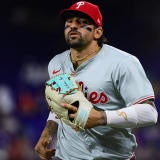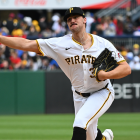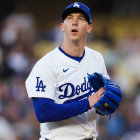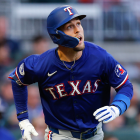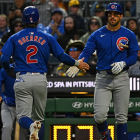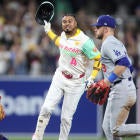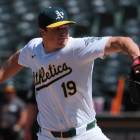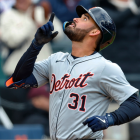It wasn't too long ago that the San Diego Padres made an ill-advised attempt to quick fix the roster and contend. During the 2014-15 offseason the Padres added Matt Kemp, Craig Kimbrel, James Shields, Justin Upton, and Wil Myers in an effort to turn around a team that went 77-85 in 2014. The club then went 74-88 in 2015, and GM A.J. Preller started the process of tearing things down.
As a result, the Padres now have one of the game's top farm systems, but the big league roster is well short of postseason caliber. FanGraphs projections peg San Diego as a 73-89 team in 2018. PECOTA also has them at 73-89. I would have a hard time arguing they're better than a 73-ish win team. The Padres (2006) have baseball's third longest postseason drought behind the Seattle Mariners (2001) and Miami Marlins (2003), and there's little reason to believe they'll reach the playoffs in 2018. Let's preview the club's upcoming season.
The vitals
- 2017 record: 71-91 (minus-212 run differential)
- 2018 depth chart: Click here.
- 2018 schedule: Click here.
- 2018 fantasy outlook: Click here.
Probable lineup
Squint your eyes and you can see the makings of an above-average offense in San Diego. The Padres still have a few too many lineup weak spots, but things are starting to look up. Here is the starting nine manager Andy Green figures to run out there come Opening Day:
- CF Manuel Margot
- 2B Carlos Asuaje
- RF Wil Myers
- 1B Eric Hosmer
- 3B Chase Headley
- LF Jose Pirela
- SS Freddy Galvis
- C Austin Hedges
- Pitcher
Bench: C A.J. Ellis, IF Christian Villanueva, UTIL Cory Spangenberg, OF Matt Szczur
Margot is a stud who looks destined to become a dynamic 20-homer, 40-steal, Gold Glove caliber leadoff man. Asuaje has the skills to play in this league for a decade as a high on-base middle infielder. Hedges is a top notch defensive catcher with pop, and those guys are hard to find. Headley and Galvis are stopgaps, not long-term solutions, but there are some nice pieces here.
Probable rotation
This is where things get a little sketchy. The Padres have some young interesting arms, but this club was near the bottom of the league in rotation ERA (4.70) and rotation WAR (+7.5) in 2017, and it's hard to see how they'll be better in 2018 without multiple big time breakouts. Here is Green's projected Opening Day rotation:
- LHP Clayton Richard
- RHP Tyson Ross
- RHP Bryan Mitchell
- RHP Dinelson Lamet
- RHP Luis Perdomo
Ross is back with the Padres following arm problems in 2016-17 and an uninspiring showing with the Texas Rangers last year. He's in camp as a non-roster player but is healthy, and is expected to land in the rotation. Mitchell, Lamet, and Perdomo are all young and have good arms, though they're still trying to figure things out at the MLB level. Matt Strahm, Robbie Erlin, Jordan Lyles, and Colin Rea are among the depth starters.
Probable bullpen
In lefty Brad Hand, the Padres have a bona fide shutdown closer who could be part of a championship caliber bullpen. Beyond him there are some, well, let's call them interesting arms. They might be more useful to the Padres long-term as possible trade chips than roster players. Here is the projected bullpen:
Closer: LHP Brad Hand
Setup: RHP Craig Stammen, RHP Kirby Yates
Middle: LHP Buddy Baumann, HHP Carter Capps, RHP Kazuhisa Makita, RHP Phil Maton
Long: RHP Jordan Lyles
Capps is the wild card. He had a magnificent 2015 season with the Marlins -- Capps struck out 58 in 31 innings with a 1.16 ERA -- but he blew out his elbow and needed Tommy John surgery. The Padres got him as a reclamation project in the Andrew Cashner trade and he hasn't been nearly as dominant since returning from elbow surgery. If Capps can regain his form as he gets further away from Tommy John surgery, it'll be a nice boost for the Padres.
Among the bullpen depth options are Adam Cimber, Kyle McGrath, Colten Brewer, Rowan Wick, and Brad Wieck. Lefty Jose Torres was placed on the restricted list recently and is facing domestic violence charges. He is not part of the club's bullpen plan at this point.
What are they expecting from Hosmer?
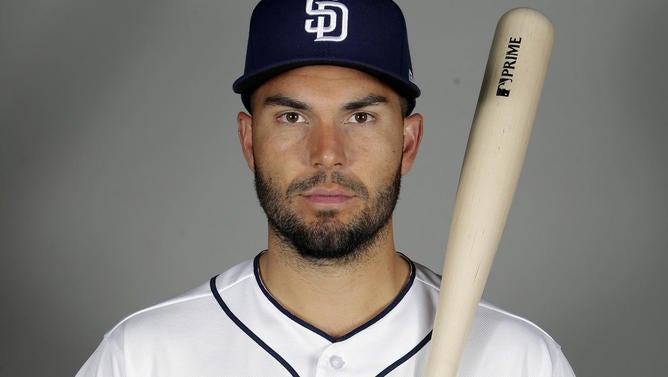
It's not often you see a no-doubt rebuilding team shell out a nine-figure contract for a free agent, but that's exactly what the Padres did with Hosmer a few weeks ago. They were after him all winter -- this wasn't a "no one saw the Padres getting involved" situation -- and they finally got their man right before the start of Cactus League games.
Hosmer signed what amounts to a five-year, $104 million contract with a three-year, $39 million insurance policy. Here is the annual salary breakdown:
- 2018: $20 million and a $4 million signing bonus
- 2019: $20 million
- 2020: $20 million
- 2021: $20 million
- 2022: $20 million with an opt-out after the season
- 2023: $13 million
- 2024: $13 million
- 2025: $13 million
Hosmer will turn 33 early in the 2022-23 offseason, and if he's still productive, he figures to opt out of his contract in search of a larger payday. If things aren't working out and his play declines, Hosmer will pass on the opt-out and collect that $39 million from 2023-25.
Clearly, the Padres did not sign Hosmer only for his bat and glove. There are plenty of first basemen who hit like Hosmer -- who hit more than Hosmer, really -- and while his glove is good, it's not $100 million good. The Padres signed Hosmer because he's a quality player and a championship caliber clubhouse guy. They want him to be at the center of their rebuild when they begin incorporating young players into the lineup.
Is that a smart way to spend $104 million? Eh, probably not, but keep in mind Hosmer's contract won't cause the Padres to miss out on any free agents in the future because the Padres are rarely in on big free agents. The upside: Hosmer is great and other free agents are more willing to come to San Diego. The downside: Hosmer is bad and the Padres lose out on a bunch of free agents who weren't going to sign with San Diego anyway. That's not so bad.
The Padres are not delusional. They know Hosmer won't put them over the top in 2018. He might be part of the long-term solution though, a player who helps on the field and even moreso in a young clubhouse in need of leaders. Hosmer is an instant respect dude. Young players look up to him and he's the type of player a rebuilding team wants mentoring their youngsters.
Is Hand a long-term piece or trade bait?
It was surprising when the Padres didn't trade Hand at the deadline last year and it was even more surprising when they signed him to a three-year contract extension worth $19.75 million over the winter. The last thing a rebuilding team needs is a high-priced closer. Hand's value is as high as it's ever going to get right now, and rather than cash him in as a trade chip, the Padres doubled down and gave him an extension.
The question now is how does he fit long-term? Is he here for the long haul? Or are the Padres still planning to trade him at some point? The contract extension makes him more valuable on the trade market, after all. Keeping him is quite risky. The Padres are likely several years away from contention and relievers are both volatile and fragile. Hand may not be a dominant -- or even serviceable -- reliever by time the team is ready to win. Trading him for prospects now is, in a sense, the safe move.
There is something to be said for respectability, and like Hosmer, Hand helps the Padres be respectable. There is nothing in baseball more demoralizing than blowing a late-inning lead. Hand is a legitimate difference-maker and one of the top relievers in baseball, and his contract is hardly onerous. As with Hosmer, I'm not going to get upset with the Padres spending money they weren't otherwise going to spend. It's unclear whether Hand is part of the future or a trade chip, and, frankly, both are defensible.
Where does Renfroe fit?
The Hosmer signing pushes Myers back into right field, and with Pirela penciled into left field -- Pirela quietly hit .288/.347/.490 (122 OPS+) with 25 doubles and 10 home runs in 83 games last year -- that means former top prospect Hunter Renfroe is a man without a position. The former first round pick hit .231/.284/.467 (97 OPS+) with 26 homers in 122 games last year. The power is legit. The on-base ability is lacking.
As things stand, Renfroe is likely ticketed for Triple-A, a level he has already conquered. The 26-year-old is a career .326/.357/.597 hitter with 40 homers in 168 Triple-A games. He has nothing left to prove at that level. Renfroe is at the point where he needs to face MLB pitching consistently and be challenged to get better. Perhaps the Padres have decided his on-base ability will never improve, and they're ready to move on. In that case, a trade seems likely. Right now Renfroe's future in San Diego is up in the air.
Be patient, lots of help is on the way
The various scouting publications all agree the Padres have a top tier farm system. They've drafted well, they've traded well, and they spent a boatload of money internationally in recent years. Here's where those scouting publications rank San Diego's farm system going into spring training:
- Baseball America: 3rd
- Baseball Prospectus: 1st
- ESPN: 3rd
- MLB.com: 1st
The Padres are loaded with talent in the farm system. There's no doubt about that. The only problem with their farm system -- and let me emphasize this isn't a Problem, just a "problem" -- is that most of their top prospects are very young and in the lower levels of the minors. MLB.com's No. 1 prospect, SS Fernando Tatis Jr., is only 19. No. 2 prospect LHP MacKenzie Gore is 19. No. 3 prospect RHP Luis Urias is 20. Four of the club's top seven prospects are teenagers. Two others are 20.
Now, it is entirely possible Tatis and Urias will make their MLB debuts in 2018. Both reached Double-A last season and they're just that damn good. Others like RHP Cal Quantrill (Paul's son) and LHP Joey Lucchesi could debut this summer as well. Generally speaking though, San Diego's best prospects are in the low minors and not especially close to the big leagues. The Padres have gobs of talent and that's important. It just might be a few years before much of that talent reaches the show.










